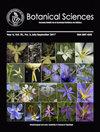A new tropical species of Aphyllon (Orobanchaceae: Orobancheae) from Chiapas, Mexico
IF 0.7
4区 生物学
Q3 PLANT SCIENCES
引用次数: 0
Abstract
Background: Aphyllon is a genus of 25 root-holoparasitic species restricted to the Americas. It has a disjunct distribution, with 21 species distributed in North America and four in South America. Aphyllon is divided into two sections: Aphyllonand Nothaphyllon. All species of the genus have host-specificity, make it a study model in the evolution of holoparasitic plants. Recently, observations of a putative new species of Aphyllon were detected on iNaturalist. Questions: Are the alluded iNaturalist observations of Aphyllon supported as a new species? What characters distinguish this taxon from the other species of Aphyllon? Studied species: Taxa of Aphyllon section Nothaphyllon. Study site and dates: Mexico; 2020–2023. Methods: Specimens were collected, dissected, measured, photographed and preserved. Herbarium specimens and literature on Aphyllon were reviewed. Comparisons of the taxon with species of section Nothaphyllon’s were performed. Results: A new species of the holoparasitic Aphyllon (Orobanchaceae) is described and illustrated. It is the second species of tropical humid vegetation in Mexico, an atypical environment for most of the genus, and it is the only species of the section with racemes with narrowed to nearly closed corolla mouths, and straight, non-revolute lobes of the lower lip. Conclusions: The records in the citizen science platform have been useful to illustrate the morphology and color of the organisms, as well as to propose new species of Aphyllon. The photographs provide information not found in herbarium specimens due to oxidation and discoloration that occurs when drying Orobanchaceae plants.文章标题墨西哥恰帕斯地区一新种(桔梗科:桔梗科)
背景:葡萄树属是一个有25种全根寄生物种的属,局限于美洲。它有一个不相交的分布,21种分布在北美,4种分布在南美。葡萄树分为两个部分:葡萄树和无葡萄树。该属的所有种都具有寄主特异性,使其成为全寄生植物进化的研究模式。最近,在《自然主义者》杂志上发现了一种疑似新种。问题:所提到的自然学家对阿夫龙的观察是否支持它是一个新种?这个分类群与其他品种有什么区别?研究种:葡萄科分类群。研究地点和日期:墨西哥;2020 - 2023。方法:标本采集、解剖、测量、拍照保存。对植物标本馆标本和文献进行了综述。对Nothaphyllon’s剖面的分类群与种进行了比较。结果:描述并说明了一新种全寄生葡萄球菌(Orobanchaceae)。它是墨西哥热带湿润植被的第二种,对大多数属来说是一个非典型的环境,它是该节中唯一具有总状花序狭窄到几乎闭合的花冠口和下唇直的,不旋转的裂片的种。结论:市民科学平台上的记录有助于阐明该生物的形态和颜色,并有助于提出该生物的新种。这些照片提供了在植物标本馆标本中找不到的信息,因为在干燥Orobanchaceae植物时发生氧化和变色。
本文章由计算机程序翻译,如有差异,请以英文原文为准。
求助全文
约1分钟内获得全文
求助全文
来源期刊

Botanical Sciences
Agricultural and Biological Sciences-Plant Science
CiteScore
1.90
自引率
21.40%
发文量
71
审稿时长
16 weeks
期刊介绍:
Botanical Sciences welcomes contributions that present original, previously unpublished results in Botany, including disciplines such as ecology and evolution, structure and function, systematics and taxonomy, in addition to other areas related to the study of plants. Research reviews are also accepted if they summarize recent advances in a subject, discipline, area, or developmental trend of botany; these should include an analytical, critical, and interpretative approach to a specific topic. Acceptance for reviews will be evaluated first by the Review Editor. Opinion Notes and Book Reviews are also published as long as a relevant contribution in the study of Botany is explained and supported.
 求助内容:
求助内容: 应助结果提醒方式:
应助结果提醒方式:


